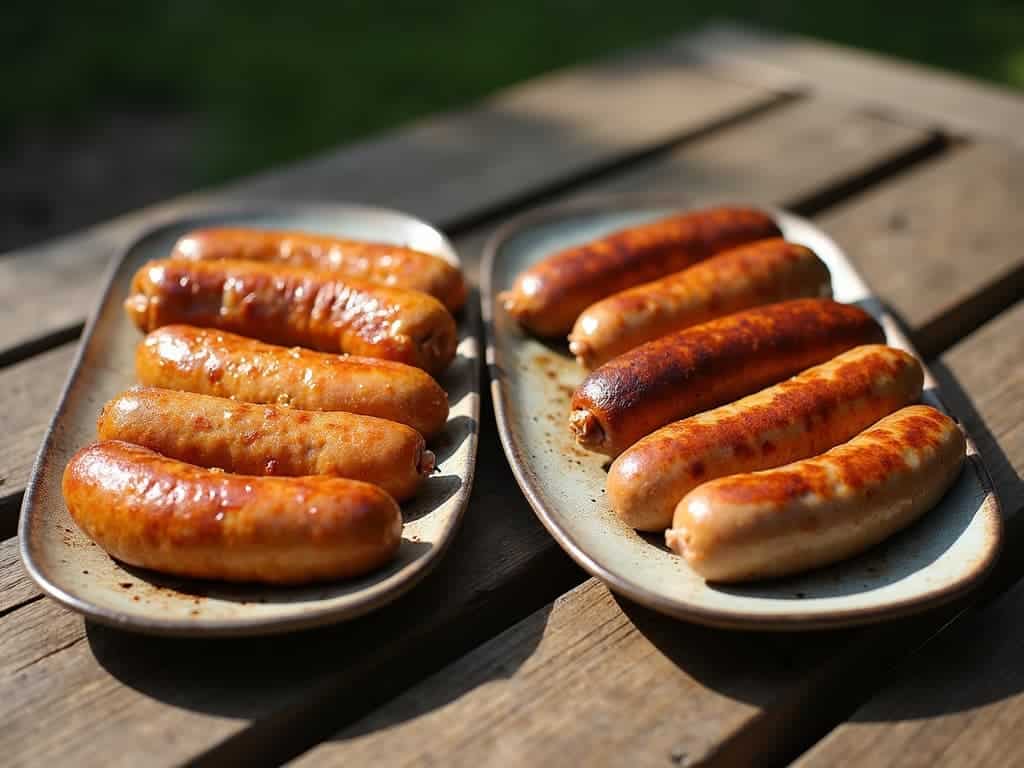Chicken sausage or turkey sausage, People picking between chicken and turkey sausage don’t need to stress – they’re both good choices that just work differently in the kitchen. Chicken sausage’s got this lighter, sweeter thing going on, and it’s pretty juicy when you cook it right.Turkey’s a bit more straightforward – kinda dry sometimes, but it grabs onto herbs real nice and has this earthiness that works in most dishes. While turkey’s got the edge on protein (about 14g per link compared to chicken’s 11g), and runs leaner overall, the final choice comes down to what you’re cooking and how you like your food. Let’s look at what makes each one special and how to get the most out of whichever you pick.
Key Takeaways
- Chicken sausage is juicier, softer, and has a mild, slightly sweet flavor that adapts well to various spices. If you’ve ever wondered how they really stack up, a chicken sausage vs turkey sausage comparison shows the biggest differences in flavor and health.
- Turkey sausage is leaner, firmer, with a savory and earthy flavor, often enhanced by herbs like sage and fennel.
- Nutritionally, turkey sausage is lower in fat and calories but higher in protein compared to chicken sausage.
Chicken Sausage Taste Comparison
Mild and Slightly Sweet Flavor Characteristics
A bite into a well-made chicken sausage reveals something interesting – there’s this unexpected touch of sweetness that’s nothing like pork or turkey. The chicken itself brings this natural sweetness (probably because it’s white meat), and it’s pretty subtle, not in-your-face sweet like maple breakfast links. The meat takes on flavors really well – toss in some garlic and herbs, maybe some red pepper, and you’ve got something that works in everything from morning eggs to pasta night. Nothing fancy about it, just good straightforward flavor that doesn’t try too hard to be something it’s not.
Juiciness and Moist Texture
When you bite into chicken sausage, there’s that telltale drip down your chin – it’s just got more fat than turkey sausage, making it tender enough to cut with a fork. The extra fat (about 2-3 grams more per link) keeps the meat from drying out, so it stays pretty darn good even if you cook it a minute too long. Throw it on a hot grill or in a sizzling pan, and the outside gets this nice brown crust while the inside stays soft and juicy, kind of like what happens when you sear a good steak. Nothing worse than dry sausage, and chicken just does better at staying moist than its turkey cousin.
Adaptability to Various Seasonings
The beauty of chicken sausage lies in its ability to take on just about any flavor thrown at it. From fiery red pepper flakes that’ll make your tongue tingle, to subtle touches of sage and thyme that remind you of Sunday dinners, this stuff just works. Anyone who’s spent time in their kitchen knows the drill – chicken sausage doesn’t fight back against seasonings, it just soaks them right up. Pretty much every cook, from the neighborhood grill master to those fancy restaurant chefs, keeps coming back to it. And why wouldn’t they? It’s probably one of the easiest meats to experiment with.
Clean and Light Aftertaste
That first taste of chicken sausage disappears pretty quick, like a whisper. The meat doesn’t stick around, coating your mouth like some heavy pork links might. There’s none of that greasy film that won’t quit. Just a quick hello and goodbye – perfect when you’re mixing it up with different side dishes or trying out new sauces on the plate.
Turkey Sausage Flavor Profile
Savory and Earthy Flavor Characteristics
The first bite of turkey vs chicken sausage hits differently than chicken – there’s something deeper going on. Maybe it’s the dark meat doing the heavy lifting, but turkey sausage packs this sort of rich, almost wild taste that chicken just doesn’t have.Not sweet at all, more like what you’d expect from something that spent its time pecking through forest floors. It’s got this natural heartiness that works really well in rustic cooking, especially when you’re trying to build layers of flavor in something like a stew or pasta sauce.
Firmer and Drier Texture Due to Leaner Meat
Anyone who’s bitten into a turkey sausage knows right away – it’s not quite the same as pork. The meat’s just leaner, and that means you’re getting something that’s a bit more solid, maybe even a touch too dry if you’re not paying attention in the kitchen.Without all that natural fat running through it, the sausage can end up pretty tough. Most cooks wind up having to baby it a bit, maybe adding a splash of stock or a pat of butter just to keep things from drying out. Not exactly a deal-breaker, but definitely something to keep in mind.
Herb-Based Seasoning Affinity
Turkey sausage just works with herbs – sage’s got this woodsy thing going on, fennel adds that hint of licorice, and mustard seed brings a nice kick. These seasonings really bring out what’s already good about the meat, and they don’t try too hard doing it. When you need something that won’t knock you over the head with flavor, turkey sausage fits the bill. Works in pretty much anything where pork might be a bit much.
Richer, Slightly Gamey Aftertaste
Turkey sausage leaves a wild tang that sticks around on the tongue, kind of like that deep woods taste you’d expect from game birds. Some folks can’t get enough of it, while others scrunch their noses a bit – there’s really no middle ground here. That extra punch of flavor makes it a natural fit for winter comfort food, especially when it’s thrown into a bubbling pot of stew or baked under a crusty casserole top.
Nutritional Attributes of Chicken and Turkey Sausages
The sausage aisle at the supermarket might leave you scratching your head. Here’s what’s what with these two leaner options (because who doesn’t love a good sausage without the guilt) (1).
Caloric Content Comparison
- Chicken sausage packs about 130 calories in each 3-ounce serving. Not bad for something that tastes so good.
- Turkey sausage comes in a bit lighter at 110 calories for the same 3-ounce portion. Yep, just twenty calories less, but hey, every little bit counts.
Fat and Saturated Fat Content
- Chicken Sausage: Each link holds about 7 grams of fat (that’s including the roughly 2 grams of the stuff that clogs arteries), enough to make you think twice but not enough to completely wreck your diet.
- Turkey Sausage: A bit better for your waistline, packing 5 grams of total fat and just 1.5 grams of the bad stuff. Pretty much your best bet if you’re watching what you eat but can’t give up your morning sausage fix.
Protein and Sodium Levels
- Turkey sausage packs a decent protein punch at 11 grams, which probably explains why gym folks grab these more often
- Chicken sausage’s not too shabby either with 7 grams of the muscle-building stuff per serving
- Salt-wise, they’re pretty much neck and neck (around 370-380 mg for a 3-ounce portion), neither one’s gonna do you any favors if you’re watching your sodium
Culinary Applications and Usage Suggestions
Chicken Sausage Culinary Versatility

Credits: Mashed
A good chicken sausage feels different than the usual pork stuff – there’s something about the way it keeps its juice that makes it pretty much perfect for throwing into just about anything.
Most folks like it in their basic pasta dishes, sure, but it’s actually pretty great crumbled up in morning eggs or scattered on a pizza. Some brands like Sabatino chicken sausage are especially popular for this since they hold flavor well while staying juicy.
The nice thing about chicken sausage is that you can blast it on the grill or toss it in a hot pan, and it doesn’t dry out like you’d think it would. Stays tender, which is more than you can say for some other lean meats.
Turkey Sausage Culinary Roles
The slightly sweet, mild-tasting meat of turkey sausage shows up all over modern cooking, and yeah, it’s got less fat than its pork cousin. Folks who’ve tried it know it works great in stuff like pasta dishes where there’s lots of garlic and herbs hanging around. The trick with turkey sausage is not letting it dry out – throw it in a pot of soup or let it simmer in some marinara sauce for a while. Some people don’t give it enough time to cook (about 15-20 minutes usually does it), but patience pays off. It’s pretty good at soaking up whatever flavors are around it, kind of like a tasty sponge in your pot of weekend stew.
Textural and Sensory Differences

Chicken Sausage Texture Characteristics
The bite of chicken sausage feels almost pillowy – there’s something about the way it holds onto fat that makes each piece feel like it might burst with juice. They’re not dense at all, and kind of give way when you press them with a fork, probably because they’ve got more fat keeping everything loose and moist inside.
Turkey Sausage Texture Characteristics
Turkey’s a different story, it’s got that tighter, more packed-together feel when you bite into it. These sausages need a watchful eye on the grill or pan since they can dry out pretty quick (nobody wants to chew through something that feels like rubber). But if you nail the timing, they’ve got this satisfying density that makes you feel like you’re eating something substantial, kind of like biting into a well-done burger patty.
Cooking and Preparation Considerations
Cooking Methods for Chicken Sausage
Chicken sausage handles high heat well. Grilling, pan-frying, or baking at medium to high temperatures helps caramelize the casing and lock in juices, resulting in a flavorful, moist sausage.
Cooking Tips for Turkey Sausage
Turkey sausage benefits from lower heat cooking and added moisture. Basting with olive oil or butter or cooking in a splash of stock helps keep it tender and prevents dryness. Avoid high heat that can toughen the meat.
Flavor Enhancement and Seasoning Adaptability
Chicken Sausage Spice Absorption
The beauty of chicken sausage lies in how it just soaks up whatever spices you throw at it, kind of like a blank canvas waiting for paint. You can go crazy with heat, dial it back with some herbs, or mix sweet and savory – the chicken sausage doesn’t fight back. Simple as that.
Turkey Sausage Flavor Base
Turkey’s got its own thing going on, and sometimes it’s pretty stubborn about it. Sure, it might not play nice with every spice in the cabinet, but when you match it up with the right stuff (like that smoky paprika or those little fennel seeds that crunch between your teeth), it really comes into its own. And don’t forget about mustard seeds – it’s like they were made for each other.
Summary and Balanced Use Recommendations
Flavor and Texture Summary
- Chicken Sausage: There’s something hearty about it – the meat stays juicy, tender to the bite, with a sweetness that’s not too much. Like grandma’s old recipes, but better.
- Turkey Sausage: A bit drier, sure, but it’s got this earthy kick to it. Feels more substantial between your teeth, and there’s a hint of game that some folks really go for.
Nutritional Trade-offs and Dietary Considerations
- Want to watch those calories? Turkey sausage is probably your best bet – it’s got more protein packed in there too.
- When you’re not counting every gram of fat, chicken sausage delivers that moisture and richness that makes weekend breakfasts worth getting up for.
Combining Chicken and Turkey Sausage
Mix these two together and something interesting happens. The turkey keeps things honest while the chicken brings the juice – it’s like they fill in each other’s gaps. Some people might think it’s weird, but toss both types into your next casserole (about half and half seems to work best), and you’ll see what all the fuss is about.
FAQ
How does sausage nutrition compare in chicken vs turkey sausage, and what about protein content, sausage calories, and sausage fat content?
Chicken vs turkey sausage both deliver poultry protein, but sausage nutrition varies. Turkey sausage often has fewer sausage calories and lower sausage fat content, while chicken can be slightly higher. Both are lean meat options compared with pork vs poultry sausage (2). For healthy sausage choices, check sausage nutrition facts like sausage fat percentage, sausage calorie count, and protein content. Either way, poultry sausage offers lean protein sources that work for sausage meal ideas without adding too much fat.
What sausage flavor profile and sausage texture differences show up in a sausage taste test, and how do sausage spices or sausage cooking methods affect results?
In a sausage taste test, chicken usually brings a lighter sausage flavor profile, while turkey feels earthier. Sausage texture differs too: chicken is often softer, turkey firmer. Sausage spices and sausage seasoning affect taste, while sausage cooking methods, grilled sausage, baked, or pan-fried, shape results.Even sausage cooking time, sausage cooking temperature, and sausage grilling tips matter. Try a sausage marinade, sausage with herbs, or sausage grilling recipes for extra flavor. These small choices create sausage flavor variations that keep recipes interesting and highlight both chicken sausage benefits and turkey sausage benefits.
What sausage nutrition facts matter most for sausage for weight loss, and how do sausage fat percentage, sausage saturated fat, and fatty acid profile compare in low-fat sausage or low-carb sausage?
If you want sausage for weight loss, focus on sausage nutrition facts like sausage fat percentage, sausage saturated fat, and fatty acid profile. Poultry sausage works better than pork vs poultry sausage for lean meat options.Low-fat sausage and low-carb sausage are healthy meats that support weight goals. Choosing all-natural sausage, sausage with herbs, or organic chicken sausage cuts sausage additives while keeping flavor. With good protein content, both turkey sausage benefits and chicken sausage benefits make them lean protein sources and healthy sausage choices.
What should I know about sausage shelf life, sausage preservatives, sausage sodium levels, and picking gluten-free sausage, paleo sausage, or keto-friendly sausage when grocery shopping?
Sausage shelf life depends on sausage packaging and whether sausage preservatives are used. Processed meats often raise sausage sodium levels, so low-sodium sausage is better. Paleo sausage, keto-friendly sausage, or gluten-free sausage fit special diets.Watch sausage casing types, sausage allergy concerns, or sausage additives if you’re sensitive. When sausage grocery shopping, check sausage nutrition and sausage calorie count for healthy sausage choices. Sausage deli meat, sausage for sandwiches, or sausage as meal prep with sausage and vegetables all fit well. Balanced sausage recipes and sausage breakfast ideas make poultry sausage a smart option.
Conclusion
Some folks swear by the rich, fatty goodness of chicken sausage, while others can’t get enough of turkey’s dense, meaty chew. They’re both good choices for different reasons – chicken’s got that melt-in-your-mouth softness, and turkey’s got a nice firm bite that takes seasonings really well. Truth is, you can’t go wrong with either one if you know your way around the kitchen. Best bet? Give ’em both a shot and see which one hits the spot for your dinner table.
References
- https://www.verywellfit.com/sausage-nutrition-facts-calories-and-health-benefits-4111299
- https://www.foodnetwork.com/healthyeats/2012/03/chicken-and-turkey-sausage-a-healthy-choice
Related Articles
- https://milkwoodrestaurant.com/chicken-sausage-vs-turkey-sausage/
- https://milkwoodrestaurant.com/turkey-vs-chicken-sausage/
- https://milkwoodrestaurant.com/sabatino-chicken-sausage/
Was this helpful?

I’m Mary R. Q. , a seasoned professional chef dedicated to elevating home cooking experiences. Through my expertise in the culinary arts, I provide practical cooking tips and insightful reviews of kitchen utensils on my blog, milkwoodrestaurant.com. As a passionate advocate for transforming everyday meals into extraordinary culinary adventures, I aim to empower home cooks with the knowledge and tools they need to create delicious and memorable dishes. I’m also an author of the book “1,001 Kitchen Tips & Tricks: Helpful Hints for Cooking, Baking, and Cleaning (1,001 Tips & Tricks)” which is sold on Amazon. Join me on a flavorful journey as we explore the art of cooking and the essential tools that make it a joy.








